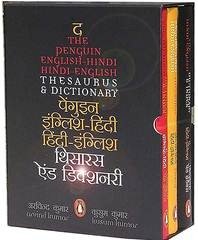We are in the throes of yet another wave of linguistic globalization, first reflected in the exhaustive international editions of Roget”s thesauruses, designed for English-speaking nations. The new world scenario calls for lexicographical works which can meet the global cross-cultural needs. Indians are contributing to the hectic global scientific, economic and cultural activity; opinion leaders, reporters, newscasters, scientists, teachers, students, and migrants have to deal with proliferating concepts in different geographical and cultural milieus. Bilingual thesauruses can suffice, to begin with, before multi-lingual ones materialize.
Makers of bilingual dictionaries would welcome one-to-one correspondences for words in any two languages. However, as linguists know, it is uncommon to find two words in two languages which have the same meanings, weights, backgrounds and associations. To give a simple example, the English word success has two Hindi equivalent words, saphalata and kamyabi. All three words have different cultural and semantic backgrounds and contexts. The word success represents a sense of reaching somewhere. Saphalata is a word emanating from an agricultural background; it literally means fruitfulness or having come to fruition. Kamyabi has an Indo-Persian origin and denotes the achievement of an objective. Its Sanskrit-based equivalent can be kritkaryata (success in one”s endeavour), a term now used for thankfulness. Success leads to succession, but neither saphalata nor kamyabi can lead one to uttaradhikar.
One is also at a loss to find the English equivalent for the commonly used Hindi word, shobha. Hindi–English and Sanskrit–English dictionaries offer a number of English words as its rough equivalents: splendour, brilliance, lustre, beauty, grace, loveliness, elegance, show… None of these is satisfactory. Shobha embodies only a fraction of these put together and a lot more.
A bilingual English–Hindi/Hindi–English thesaurus was the obvious way around this predicament. For a concept in either language, it would offer a host of options to choose from, far exceeding the potential of a simple dictionary.
India has a very high density of English-knowing and -speaking people; many Indians have been educated through the English medium and are more comfortable using English than Hindi. There are also many first- and second-generation non-resident Indians, especially in the USA and UK, non-Indian researchers and scholars of Hindi, others who wish to enrich their Hindi and English vocabularies or some who simply wish to look up a correct Hindi word for an English one. There are also several people translating into and from Hindi and need parallel Hindi/English words. In addition, there are non-English non-Indians who learn English to learn Hindi, as a bridge between their mother tongue and Hindi. South Asians who share cultural traits with us can also be included in the list of people for whom such a work would be useful. Also, for the many non-Indians who would like to understand South Asian terms in the context of their own sensibilities, such a work would be needed.
With these factors in mind, we started work on an English–Hindi word bank in 1997.
We took the Hindi data as the base. Now, the first step was to add, in the FoxPro table, columns to accommodate corresponding English headings, subheadings and synonyms. The next was to find equivalent English words for them in the Samantar Kosh. To help us, our daughter Meeta Lall, gold-medallist MSc in Nutrition from Delhi”s Lady Irwin College, willingly took up jotting down the English equivalents in a copy of the Samantar Kosh. (She later edited our data on food, nutrition, and health.)
From here on, it was Arvind”s task to find and add more English words for all the subheads. Kusum would sometimes be pressed in to look up Hindi–English, English–Hindi, and standalone English dictionaries to check and cross-check meanings.
Once the Hindi to English part was done, we knew a large number of non-Hindi concepts must have been left out since our data was basically Hindi and Indian. To ensure a true bilingual character with cross-cultural references, we now engaged in entering words from the English vocabulary, going from A to Z. Unique English expressions had to be inserted and linked to Indian culture at appropriate places and Hindi equivalents added for them. This process of cross-fertilization has helped us change, enrich and improve the Hindi data too. Many new categories have been added, and many more expressions included.
Now we may rightfully claim to have a rich cross-cultural bilingual data of English and Hindi expressions, linking Indian and principal world cultures. We can also claim to have developed a unique easy-to-use database system, adaptable to the growing requirements of a lexicographic group.
The initial programming and first entries to the data on the English–Hindi/Hindi–English thesaurus and dictionary were made in Kuala Lumpur (Malaysia) where Sumeet was getting his hospital management system installed. Since then the work has moved from country to country and within India from town to town. For two years, we worked on it in Dallas (Texas) and Tulsa (Oklahoma). In India, we worked on it in Ghaziabad and Chennai. The last four years saw us work in Pondicherry (renamed Pudducherry) and Auroville, founded in 1968 as an international township that aspires to realize human unity. As a consequence of the growing worldwide influence of Sri Aurobindo and the Mother, Auroville has residents from over forty countries, engaged in cross-cultural exchange, social experimentation and innovation.
(From the Preface to The Penguin English–Hindi/Hindi–English Thesaurus and Dictionary)
Now available from:
Messrs Arvind Linguiustics Pvt Ltd
E-28, 1st Floor, Kalindi Colony, New Delhi 110065

Comments